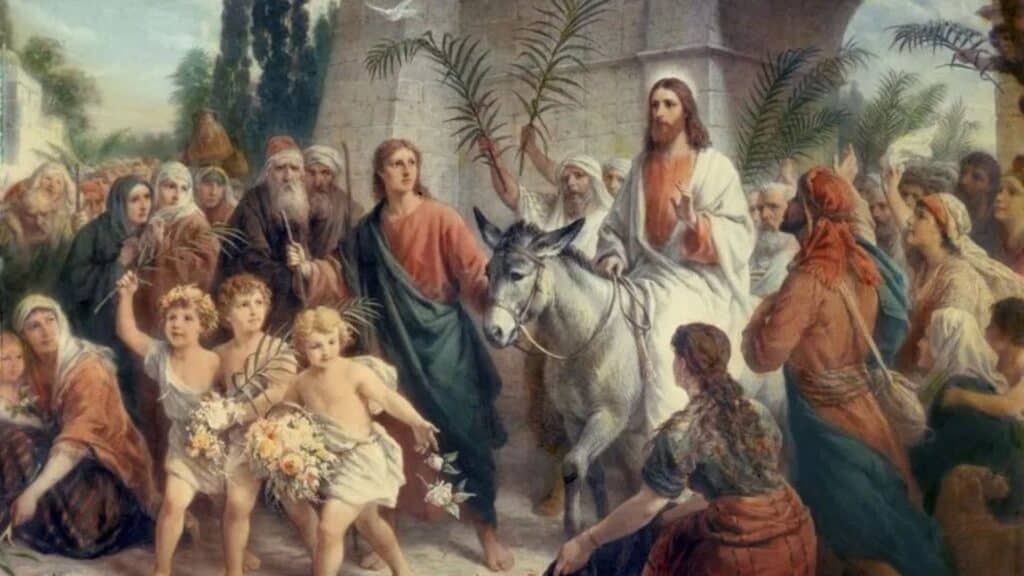Every year, Christians around the world enter into the solemn observance of Holy Week, the most sacred period in the liturgical calendar.
It is a time of deep reflection, devotion, and renewal, culminating in the celebration of Christ’s resurrection, which is considered “the central event of the Christian faith.”
But beyond the familiar rituals, what do these sacred days truly signify? Why does Holy Week hold such profound meaning for believers?
Fr. Ronmarth Reysan Cabase, secretary to the archbishop, seminary professor, and expert in church history, shed light on the spiritual depth of the Holy Week as he shared his insights in an interview with CDN Digital.
READ;
Holy Week: A peek into 7 Metro Cebu churches for Visita Iglesia
Holy Week 2024: Religious places you can visit in Cebu
Here are the most common Holy Week traditions in the Philippines
“At the heart of our Christian faith is the Passion, Death, and Resurrection of Jesus Christ. Saint Paul himself said that without the Resurrection, our faith is in vain,” Fr. Cabase said.
“Holy Week is an intense preparation leading up to these pivotal events, particularly the Triduum—Holy Thursday, Good Friday, and Holy Saturday. These are the very foundation of our beliefs,” he added.
Each day of Holy Week unfolds like a chapter in the greatest story ever told. It is a journey from exaltation to betrayal, suffering to silence, and ultimately, from death to new life.
Palm Sunday
![]()

SuperStock / Getty Images
The streets of Jerusalem erupt in celebration as Jesus enters the city, riding humbly on a donkey. Crowds lay their cloaks on the road and wave palm branches, shouting:
“Hosanna to the Son of David! Blessed is He who comes in the name of the Lord!” (Matthew 21:9)
It is a moment of victory and expectation, yet a tragic irony looms.
The same voices that welcome Him today will demand His crucifixion by Friday.
“There’s something deeply symbolic about this,” Fr. Cabase said. “We, too, can be like the Jews—professing faith one moment, yet rejecting Christ by our actions. Sometimes, we claim to believe, yet live in ways that contradict that faith.”
The palm branches, symbols of triumph, also serve as warnings against shallow faith. They remind us that following Christ requires more than momentary enthusiasm—it demands unwavering discipleship.
On Palm Sunday, churches worldwide commemorate Jesus’ entry by waving palm branches. Many dry and weave them into crosses, while traditional congregations sing hymns like “All Glory, Laud, and Honor.”
Holy Monday to Holy Wednesday
As Jesus spends His final days in Jerusalem, the tension deepens.
The path to Calvary is already being paved, not just by the religious leaders who seek His death, but by one of His own.
If Palm Sunday was filled with hope, the following days carried an air of impending darkness.

Rischgitz/Getty Images
On Holy Monday, Jesus entered the Temple in Jerusalem and was enraged by what He saw—money changers and merchants exploiting the sacred space for profit. The very place meant for worship and prayer had been reduced to a marketplace, where greed overshadowed devotion.
Outraged by the corruption and dishonor, He overturned tables and drove out those who had turned His Father’s house into a den of thieves, reaffirming the Temple’s true purpose as a house of prayer.
“My house shall be called a house of prayer, but you have made it a den of thieves.” (Matthew 21:13)
For Fr. Cabase, this moment speaks to the importance of true worship, the one that prioritizes God above personal gain.
“Some people argue that churches spend too much money on beautiful altars and sacred vessels when the poor need help. But in reality, God deserves the best. If we can spend on politicians and lavish celebrations, how much more for the Lord?” Fr. Cabase said.

Andrew_Howe / Getty Images
By Holy Tuesday, the shadow of betrayal grew heavier, inching closer to its inevitable fulfillment.
As Jesus gathered with His disciples, He made a chilling revelation:
“One of you will betray Me.” (John 13:21)
The air in the room grew thick with tension. Shock and disbelief flickered across the disciples’ faces as they exchanged uneasy glances, whispering in hushed tones. Each wrestled with the unsettling thought—who among them could be capable of such a treachery?
Meanwhile, Judas Iscariot, already entangled in secret dealings with the chief priests, concealed his guilt behind a mask of loyalty. The silver coins that sealed his betrayal lay hidden, the weight of his deception buried beneath a feigned innocence.

Apic / Getty Images
By Holy Wednesday, often called “Spy Wednesday,” the betrayal was set in motion.
Judas, lured by greed and disillusionment, struck a deal to hand Jesus over for thirty pieces of silver—the price of a common slave.
“Judas was present during these three days. It’s haunting how he stayed close to Jesus while secretly plotting against Him. We, too, can betray God in subtle ways—through hypocrisy, greed, or failing to stand up for what is right,” Fr. Cabase pointed out.
Maundy Thursday

Leemage/UIG via Getty Images
The Upper Room is filled with quiet solemnity. It is the night of the Last Supper, and Jesus, fully aware of what is to come, gives His disciples two of His greatest gifts.
He takes the bread, blesses it, and says:
“This is My body… This is My blood… Do this in remembrance of Me.” (Luke 22:19-20)
With these words, the Eucharist is instituted—the living presence of Christ among His people.
Then, in a moment of profound humility, Jesus kneels and washes the feet of His disciples. The Lord of all creation lowers Himself to serve, teaching us that true greatness is found not in power, but in love and selflessness.
“No priesthood, no Eucharist. That’s why Holy Thursday is so important. It was the night Jesus gave us the Sacrament of the Eucharist and the Priesthood,” Fr. Cabase emphasized.
Yet, even on this sacred night, darkness creeps in.
In the Garden of Gethsemane, Jesus prays in anguish, His sweat like drops of blood. He pleads with the Father, yet submits to His will. And then—footsteps. Torches. A kiss.
Judas has arrived. The betrayal is complete.
Many churches, particularly Lutheran and Catholic traditions, observe a Tenebrae service (Tenebrae meaning “shadow”). In this solemn ritual, candles or lights in the sanctuary are gradually extinguished as the altar is stripped bare, symbolizing Christ’s growing isolation.
Some services conclude with a loud noise, a reminder of the chaos to come, while others mark the beginning of the Triduum, the three-day journey through Christ’s passion, death, and resurrection.
Good Friday

Close-up of “Crucifixion” by Bramantino, 1510, oil on panel, 372 x 270 cm. DEA / G. CIGOLINI / Getty Images
The day begins with brutality. Jesus is scourged, mocked, and crowned with thorns. The same crowd that once cried “Hosanna!” now roars:
“Crucify Him! Crucify Him!”
He is led to Golgotha, carrying a cross too heavy for one man to bear. Nails pierce His hands and feet. The sky darkens. The earth trembles. And with one final breath, He cries:
“It is finished.” (John 19:30)
But why is this day called Good?
“Saint Thomas Aquinas called Adam and Eve’s sin a ‘felix culpa’—a ‘happy fault’—because, through it, God became man. In the same way, Good Friday is ‘good’ because through Jesus’ suffering, we received redemption. His wounds opened the gates of heaven for us,” Fr. Cabase explained.
It is a day of grief, yet also of hope, because this is not the end.
Many churches hold special Good Friday services featuring the Stations of the Cross, where prayers and Scripture readings recount Jesus’ arrest, trial, and crucifixion. Passion plays bring these events to life, with members portraying Jesus, Peter, Pontius Pilate, and others.
In the Philippines, some devout faithful take commemoration further with intense acts of penitence, including self-flagellation and even crucifixion reenactments. Fasting, silence, and deep reflection mark the solemnity of this sacred day.
Black Saturday

Disciples at the scene of the entombment of Jesus after his crucifixion. Hulton Archive/Getty Images
The world is quiet. The Savior lies in the tomb.
For the disciples, it is a day of sorrow and uncertainty. But for God, it is a day of unseen triumph. Even in death, Christ is at work, descending to the depths to shatter the chains of sin and conquer death itself.
“Sometimes, God seems silent in our lives,” Fr. Cabase said. “But silence is not absence. Holy Saturday teaches us to trust—even in the waiting.”
Holy Saturday, also known as the Easter Vigil, is observed in various ways. Some churches hold solemn prayer vigils, lighting commemorative candles to symbolize the coming light of Christ’s resurrection.
Others, recognizing the end of Lent, mark the occasion with the joyous ringing of bells. The days of the Holy Week are about to end. At home, families prepare for the next day’s Easter celebration, awaiting the dawn of hope and new life.
Easter Sunday

The Garden Tomb in Jerusalem, believed to be the burial place of Jesus. Steve Allen / Getty Images
At dawn, everything changes. The stone is rolled away. The tomb is empty.
“He is not here; He has risen, just as He said!” (Matthew 28:6)
With this, death is defeated, and the promise of eternal life is fulfilled. Fr. Cabase shared that resurrection is not merely a historical event, but the very foundation of the Christian faith, the victory that gives meaning to every believer’s hope.
Easter’s widespread celebration, even among nominal Christians and non-Christians alike, ensures no shortage of Sunday festivities—or beloved traditional foods—marking the joy of new life and redemption.
Living Holy Week beyond these days
Holy Week is not just a yearly observance. It is an invitation to walk with Christ, not only in the days of the Holy Week but in the choices we make every day.
“At the start of Lent, we are encouraged to fast, pray, and give to others. Essentially, these are moments when we slow down in life and take time to reflect on our faith. As we prepare, we focus on the three pillars of the Lenten season: praying more, practicing self-denial, and being more generous in giving to others. That is its true purpose,” Fr. Cabase said.
